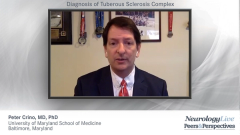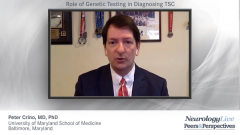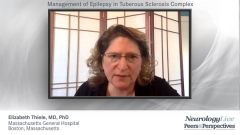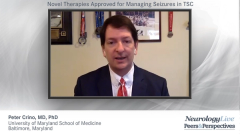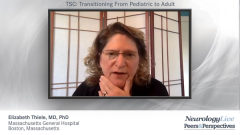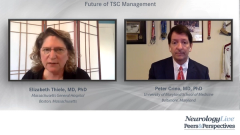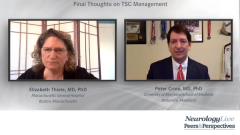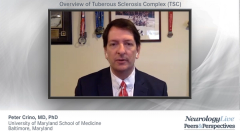
Diagnostic Criteria for Tuberous Sclerosis Complex
Peter Crino, MD, PhD, and Elizabeth Thiele, MD, PhD, review the major and minor diagnostic criteria for TSC based on the 2012 International Tuberous Sclerosis Complex Consensus Recommendations.
Episodes in this series

Elizabeth Thiele, MD, PhD: You mentioned the major and minor criteria that you use for diagnosis. The latest Tuberous Sclerosis [TS] Complex International Consensus conference was in 2012, and we’re working on revisions of that now. Can you briefly review what that means, major and minor criteria?
Peter Crino, MD, PhD: When we initially were assembling diagnostic criteria, we had put together in the original days definite, possible, and probable. We’ve reupped that and reevaluated, and we have come up with 2 broad diagnostic categories largely based on clinical criteria. This includes definite TS. Definite tuberous sclerosis is defined by the presence of 2 of the major diagnostic features, or 1 of the major diagnostic features plus 2 minor features, and we can talk about that. Possible tuberous sclerosis is someone who comes in who has 1 major diagnostic feature or more than a couple of minor diagnostic features. Until the advent of genetic testing, clinical diagnosis was how we made a diagnosis of tuberous sclerosis. Basically, we look across the series of organ systems, including the brain, the eyes, the lungs, the skin, and the kidneys, to look for the major diagnostic features.
In the brain, the major diagnostic features include malformations of cortical development; subependymal giant cell nodules, which are small nodules in the ventricular system in the brain; and tumors. Not cancer tumors, but benign growths inside the brain that are not actually benign; they can cause a lot of problems for patients. Any of those, if seen on an MRI scan, would be considered a major diagnostic feature. In the skin, we have a number of features from facial angiofibromas, which are reddish lesions that can appear on the face. They are a major diagnostic feature. Subungual fibromas, which are warty lesions around the nail, are a major diagnostic criterion. The so-called shagreen patch—or collagenous fibroadenoma, which is often seen in the lumbosacral flank region—is a major feature. The classic so-called hypomelanotic macule used to be called the ash-leaf spot—many of us in medical school learned it as the ash-leaf spot. It’s an area of diminished or absent pigmentation often seen multiple in the body.
All those are major diagnostic features. In the lung, there is lymphangioleiomyomatosis, which is a progressive lung disease seen almost exclusively in women with tuberous sclerosis complex [TSC]. In the kidney, there are lesions known as angiomyolipomas. Angiomyolipomas can be seen in the kidney most commonly but also in other visceral organs, including the liver. The eye, which is part of the nervous system but is a little different, has characteristic lesions known as retinal hamartomas. These are basically malformations or abnormalities in the retina. All those are considered to be major diagnostic criteria. If I see a patient who’s come in with either a first-time seizure, or as I was mentioning before, the parent of a child with TSC, those are the things that I’m going to surveil for. Quite simply, you assemble a checklist of those features, and anyone who’s got more than 2 major diagnostic criteria—hypomelanotic macules and angiofibromas and a tuber the brain—by clinical criteria has definite tuberous sclerosis. For someone who has only has 1 of those and a couple of minor features, which we can discuss, we would say that it’s possible tuberous sclerosis. We’d want to do more investigation with imaging or even genetic testing to confirm that diagnosis.
Elizabeth Thiele, MD, PhD: That concept of possible TSC is an important 1. As you know, these different organ involvements can occur at different times during individuals’ lives. If I have a child who might have multiple rhabdomyomas, and I know the criteria at that time, if I do genetic testing and find the disease-causing mutation, I know that child has TSC. If for some reason I can’t or if no mutation is found, it’s still important to follow that child because that person likely has TSC with multiple cardiac rhabdomyomas. To minimize the impact of TSC on an individual’s health, they should be followed closely. We follow those people, but we don’t necessarily do the recommended surveillance testing at the same intervals in the possible TSC or probable TSC. It’s important because for many of them…if you do the clinical diagnostic work-up at birth with the baby’s rhabdomyomas, probably some people with TSC were missed because they didn’t meet criteria at that time.
Peter Crino, MD, PhD: Absolutely.
Elizabeth Thiele: I tell my patients and other people: The major criteria are things that we see very frequently in TS that can be seen in the general population but not as frequently. For example, renal angiomyolipoma [AML] is not rare, but it’s pretty unusual to have multiple bilateral AMLs outside of TSC. Regarding the minor criteria, we can go through them. We just mentioned that there are things that we see in TS but are also seen in the general population. They’re not as specific. I have diagnosed 1 person over the years by using the minor criteria. It’s pretty unusual because we know the brain and the skin affected 95% of people with TS, so it’s often possible to do then.
I’d like to thank the audience for watching this Neurology Live® webinar. If you enjoyed the content, please subscribe to our e-newsletters to receive upcoming programs and other great content right in your in-box.
Transcript Edited for Clarity
Newsletter
Keep your finger on the pulse of neurology—subscribe to NeurologyLive for expert interviews, new data, and breakthrough treatment updates.

